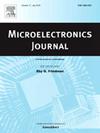Humidity and ring spacing variation tolerant design of a SiC power MOSFET using mirrored floating field rings
IF 1.9
3区 工程技术
Q3 ENGINEERING, ELECTRICAL & ELECTRONIC
引用次数: 0
Abstract
Prior designs of the number and spacing of the Floating Field Rings (FFRs) in the edge termination of SiC MOS-FETs have limitations. They neglect the possible degradation of the breakdown voltage, VBR, due to two reasons: (1) widening, α, of the ring due to lateral straggle of dopants during implant-action, and over-etching of the window during the prior lithography step; (2) presence of a negative SiC/SiO2 interface charge, QH, over a part or whole of the edge termination length due to migration of aluminates formed from reaction of the gate metal with humidity in the environment. We propose an improved algorithm to design a FFR structure considering α. Further, we show that by extending this structure by its mirrored version, we get what we call a Mirrored FFR (MFFR) structure, which is tolerant to QH as well as α. The concept is illustrated using well calibrated TCAD simulations of a 600 V SiC MOSFET with α = 0.3 μm and QH = − 3 × 1012 cm−2; the VBR with prior FFR designs degraded by up to 48 % while that with MFFR design by just 16 %. Thus, MFFR structure yields a device with the least overhead factor of VBR, that in turn allows realization of a lower specific on-resistance.
求助全文
约1分钟内获得全文
求助全文
来源期刊

Microelectronics Journal
工程技术-工程:电子与电气
CiteScore
4.00
自引率
27.30%
发文量
222
审稿时长
43 days
期刊介绍:
Published since 1969, the Microelectronics Journal is an international forum for the dissemination of research and applications of microelectronic systems, circuits, and emerging technologies. Papers published in the Microelectronics Journal have undergone peer review to ensure originality, relevance, and timeliness. The journal thus provides a worldwide, regular, and comprehensive update on microelectronic circuits and systems.
The Microelectronics Journal invites papers describing significant research and applications in all of the areas listed below. Comprehensive review/survey papers covering recent developments will also be considered. The Microelectronics Journal covers circuits and systems. This topic includes but is not limited to: Analog, digital, mixed, and RF circuits and related design methodologies; Logic, architectural, and system level synthesis; Testing, design for testability, built-in self-test; Area, power, and thermal analysis and design; Mixed-domain simulation and design; Embedded systems; Non-von Neumann computing and related technologies and circuits; Design and test of high complexity systems integration; SoC, NoC, SIP, and NIP design and test; 3-D integration design and analysis; Emerging device technologies and circuits, such as FinFETs, SETs, spintronics, SFQ, MTJ, etc.
Application aspects such as signal and image processing including circuits for cryptography, sensors, and actuators including sensor networks, reliability and quality issues, and economic models are also welcome.
 求助内容:
求助内容: 应助结果提醒方式:
应助结果提醒方式:


